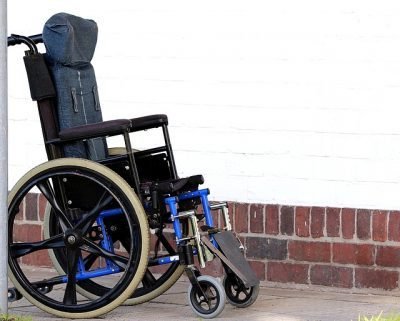You may have seen or ridden a standard wheelchair at a clinic or at the airport, but for a wheelchair you’ll be using extensively and for a lot longer as part of your daily lives, for instance to cope with conditions like rheumatoid arthritis or the aftermath of a stroke, there’s plenty of considerations to take into account. The wheelchair you pick must suit the needs of the person using it, the space it will be used in, and even how long it will be used for. So we’re here to break down the main features of a wheelchair you’ll have to give some thought to before getting to your final pick.
How is the wheelchair powered?
First and foremost, it’s important to understand that wheelchairs can be broadly categorised into two groups: manual, and powered. There are subcategories within each, but as the name suggests, manual wheelchairs are controlled, pushed and propelled by people – in other words, yourself or a caregiver – while a powered wheelchair, also known as an electric wheelchair, runs on motor and battery.
 Manual wheelchairs can be self-propelled – these guys have big, sturdy rear wheels to handle bumps and uneven terrain, with push rims to let the user maneuver themselves without needing to grip the wheels. These wheelchairs are great if you have the stamina and upper body strength to operate them, giving you the independence of mobility without needing to rely on others to help you out.
Manual wheelchairs can be self-propelled – these guys have big, sturdy rear wheels to handle bumps and uneven terrain, with push rims to let the user maneuver themselves without needing to grip the wheels. These wheelchairs are great if you have the stamina and upper body strength to operate them, giving you the independence of mobility without needing to rely on others to help you out.
Nonetheless, manual wheelchairs usually do come with push-handles to let a caregiver or helpful stranger lend you a hand, since navigating a wheelchair manually for too long a period of time and over tricky terrains – up a slight incline, into an elevator and so on – can sometimes be difficult to manage on one’s own. For those of us who may be experiencing arthritis or a lack of dexterity and strength in our upper body and particularly our arms, manual wheelchairs can also be attendant-propelled – with smaller rear wheels, your caregiver or companion pushes and steers the wheelchair for you.
 Typically, manual wheelchairs can be folded up and transported more easily compared to electric options. Some wheelchairs are specifically created for transport, and are lightweight, foldable and portable for tucking into the car trunk and short trips to the mall or for dinner. Standard wheelchairs are for more prolonged use throughout the day, usually heavier and with additional features to keep you comfortable, like elevated leg-rests, padded seats and backrest, wider armrests and so on.
Typically, manual wheelchairs can be folded up and transported more easily compared to electric options. Some wheelchairs are specifically created for transport, and are lightweight, foldable and portable for tucking into the car trunk and short trips to the mall or for dinner. Standard wheelchairs are for more prolonged use throughout the day, usually heavier and with additional features to keep you comfortable, like elevated leg-rests, padded seats and backrest, wider armrests and so on.
For those lacking upper body mobility, but who don’t wish to rely on someone else to give them the flexibility of movement they desire, an electric wheelchair is a great alternative. An intuitive joystick or remote control system – and in some models a handle-bar system reminiscent of mobility scooter tillers – lets you steer the wheelchair without requiring excessive exertion or effort. Electric wheelchairs are sometimes less portable – though some models do fold up – because they carry a motor and battery on board, and have to be charged by mains electricity prior to use.
Where are you going to use the chair?
Depending on the usage and intended usage space, you’ll be looking at different models of wheelchairs. For exclusively indoor use, be it at home or over even, smooth flooring in spaces like shopping malls, clinics, schools and so on, wheelchairs will not be as rugged and heavy-duty as wheelchairs you intend to use outdoors and over uneven terrain. Outdoor wheelchairs tend to be bigger and bulkier than more maneuverable and narrow indoor wheelchairs, to withstand any bumps and scrapes, with larger and more rugged wheels and better suspension. If you’re looking for a bit of both, hybrid indoor-outdoor wheelchairs find a mid-point between indoor-friendliness and outdoor-resilience.
Wheelchair dimensions
Once you’ve settled on the type of wheelchair you want, it’s time to take a look at your wheelchair’s dimensions to make sure your pick is the most comfortable and healthy option for you.
 You don’t want a chair that leaves your feet dangling off the ground without reaching the floor or resting easily on your footrest, but you also don’t want to have to scrunch up your knees and have your feet dragging on the floor either. Your height factors into how high your seat should be from the floor – typically, wheelchair seats are about 20 inches above the ground, suitable of people around 5 feet tall. You’ll have to look for seats higher than this if you’re taller, and lower if you’re shorter.
You don’t want a chair that leaves your feet dangling off the ground without reaching the floor or resting easily on your footrest, but you also don’t want to have to scrunch up your knees and have your feet dragging on the floor either. Your height factors into how high your seat should be from the floor – typically, wheelchair seats are about 20 inches above the ground, suitable of people around 5 feet tall. You’ll have to look for seats higher than this if you’re taller, and lower if you’re shorter.
The depth of the wheelchair also factors in. Depth refers to the distance of the seat from the backrest to the seat’s edge. A handy rule of thumb approach is to measure this distance on a chair you can settle into comfortably, giving both your back and your feet the adequate support without damaging your posture, and looking for a wheelchair with the same seat depth.
Another important consideration is the armrest width – the space between the armrests, which determines if you can actually comfortably fit into the chair. Again, measuring this distance with a chair you’re comfy in at home or at work can give you an idea of the ideal armrest width, so you pick the right-sized wheelchair to hold your frame comfortably. Depending on the model and type of wheelchair you pick, the armrests of wheelchairs can be foldable, height adjustable, and either full length (running from the backrest to the edge of the chair) or partial length, to let you push the chair right up to the edge of a table or desk with your legs sliding under it. The important thing to note is that armrests should enhance your comfort, and give your shoulders and arms the right support.
Lastly, look out for your potential wheelchair’s weight capacity. A good wheelchair will be able to hold well above your weight, while one that’s under-capacity risks destabilizing and resulting in unfortunate and avoidable accidents.
Customizable features
Backrests are generally a standard height, but can be padded with a headrest attached for extra support and comfort, while we recommend throwing in a wheelchair cushion or picking a chair with a padded seat if you’re going to be spending long periods of time in it.
Removable footrests are also a great option to look out for, so your feet have the added stability of getting to rest without hanging off the edge of your seat and debilitating your posture, while elevating leg rests let you push up the extension so you can recline and rest your limbs.